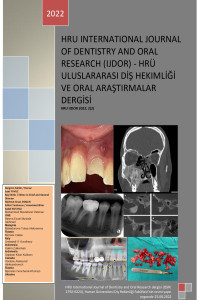Çocuk Diş Hekimliğinde Davranış Yönetimi
Davranış yönlendirme, diş tedavisi, sedasyon
Behaviour Management in Pediatric Dentistry
Behavior management, dental treatment, sedation,
___
- 1. Mallineni SK, Yiu CK. Dental treatment under general anesthesia for special-needs patients: analysis of the literature. Journal of investigative and clinical dentistry. 2016;7(4):325-31.
- 2. Jamali Z, Najafpour E, Ebrahim Adhami Z, Sighari Deljavan A, Aminabadi NA, Shirazi S. Does the length of dental procedure influence children's behavior during and after treatment? A systematic review and critical appraisal. Journal of dental research, dental clinics, dental prospects. 2018;12(1):68-76.
- 3. Guideline on Behavior Guidance for the Pediatric Dental Patient. Pediatric dentistry. 2016;38(6):185-98.
- 4. Sheller B. Challenges of managing child behavior in the 21st centurydental setting. Pediatric dentistry. 2004;26(2):111-3.
- 5. Long N. Stress and economic hardship: the impact on children and parents. Pediatric dentistry. 2014;36(2):109-14.
- 6. Baier K, Milgrom P, Russell S, Mancl L, Yoshida T. Children's fear and behavior in private pediatric dentistry practices. Pediatric dentistry. 2004;26(4):316-21.
- 7. Arnrup K, Broberg AG, Berggren U, Bodin L. Lack of cooperation in pediatric dentistry--the role of child personality characteristics. Pediatric dentistry. 2002;24(2):119-28.
- 8. Rud B, Kisling E. The influence of mental development on children's acceptance of dental treatment. Scandinavian journal of dental research. 1973;81(5):343-52.
- 9. Hamzah HS, Gao X, Yung Yiu CK, McGrath C, King NM. Managing dental fear and anxiety in pediatric patients: A qualitative study from the public's perspective. Pediatric dentistry. 2014;36(1):29-33.
- 10. Adair SM, Schafer TE, Rockman RA, Waller JL. Survey of behavior management teaching in predoctoral pediatric dentistry programs. Pediatric dentistry. 2004;26(2):143-50.
- 11. Wells MH, McCarthy BA, Tseng CH, Law CS. Usage of Behavior Guidance Techniques Differs by Provider and Practice Characteristics. Pediatric dentistry. 2018;40(3):201-8.
- 12. Law CS, Blain S. Approaching the pediatric dental patient: a review of nonpharmacologic behavior management strategies. Journal of the California Dental Association. 2003;31(9):703-13.
- 13. Tsai CL, Tsai YL, Lin YT, Lin YT. A retrospective study of dental treatment under general anesthesia of children with or without a chronic illness and/or a disability. Chang Gung medical journal. 2006;29(4):412-8.
- 14. Nash DA. Engaging children's cooperation in the dental environment through effective communication. Pediatric dentistry. 2006;28(5):455-9.
- 15. Feigal RJ. Guiding and managing the child dental patient: a fresh look at old pedagogy. Journal of dental education. 2001;65(12):1369-77.
- 16. Goleman J. Cultural factors affecting behavior guidance and family compliance. Pediatric dentistry. 2014;36(2):121-7.
- 17. Eaton JJ, McTigue DJ, Fields HW, Jr., Beck M. Attitudes of contemporary parents toward behavior management techniques used in pediatric dentistry. Pediatric dentistry. 2005;27(2):107-13.
- 18. Guideline for Monitoring and Management of Pediatric Patients Before, During, and After Sedation for Diagnostic and Therapeutic Procedures: Update 2016. Pediatric dentistry. 2016;38(6):216-45.
- 19. Kamath PS. A novel distraction technique for pain management during local anesthesia administration in pediatric patients. The Journal of clinical pediatric dentistry. 2013;38(1):45-7.
- 20. Pickrell JE, Heima M, Weinstein P, Coolidge T, Coldwell SE, Skaret E, et al. Using memory restructuring strategy to enhance dental behaviour. International journal of paediatric dentistry. 2007;17(6):439-48.
- 21. Pinkham JR. An analysis of the phenomenon of increased parental participation during the child's dental experience. ASDC journal of dentistry for children. 1991;58(6):458-63.
- 22. Nunn J, Foster M, Master S, Greening S. British Society of Paediatric Dentistry: a policy document on consent and the use of physical intervention in the dental care of children. International journal of paediatric dentistry. 2008;18 Suppl 1:39-46.
- 23. Nelson TM, Xu Z. Pediatric dental sedation: challenges and opportunities. Clinical, cosmetic and investigational dentistry. 2015;7:97-106.
- 24. Litman RS, Kottra JA, Verga KA, Berkowitz RJ, Ward DS. Chloral hydrate sedation: the additive sedative and respiratory depressant effects of nitrous oxide. Anesthesia and analgesia. 1998;86(4):724-8.
- 25. Maxwell LG, Yaster M. The myth of conscious sedation. Archives of pediatrics & adolescent medicine. 1996;150(7):665-7.
- 26. Barker SJ, Hyatt J, Shah NK, Kao YJ. The effect of sensor malpositioning on pulse oximeter accuracy during hypoxemia. Anesthesiology. 1993;79(2):248-54.
- 27. Goodson JM, Moore PA. Life-threatening reactions after pedodontic sedation: an assessment of narcotic, local anesthetic, and antiemetic drug interaction. Journal of the American Dental Association (1939). 1983;107(2):239-45.
- Başlangıç: 2021
- Yayıncı: Harran Üniversitesi
Mehmet Emin DOĞAN, Elif Meltem ASLAN ÖZTÜRK
Çocuk Diş Hekimliğinde Davranış Yönetimi
The Condition of the Oral Mucosa of Patients with Covid-19
Svetlana V. DYACHENKO, Makedonova Yuliya ALEKSEEVNA, Ludmila M. GAVRİKOVA, Denis Yu. DYACHENKO, İzzet YAVUZ
Kübra MUMCU, Mehmet Sinan DOĞAN, Mehmet GÜL, Mehmet Veysel KOTANLI, Michele CALLEA
